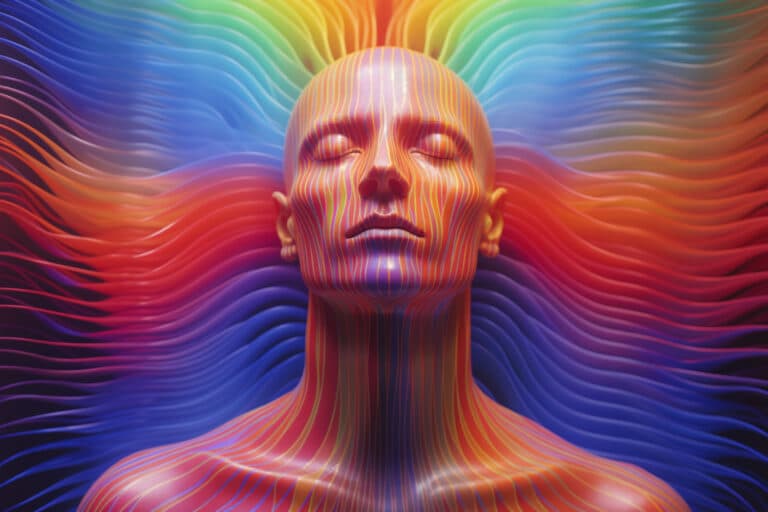4 min read
Types of Synesthesia
Synesthesia is a fascinating neurological condition where stimulation of one sensory or cognitive pathway leads to automatic, involuntary experiences in a second sensory or cognitive pathway. Individuals with synesthesia might see colors when they hear music or taste flavors when they touch certain textures. Let’s explore the various types of synesthesia and their unique characteristics.

Definition of synesthesia
Synesthesia is a neurological condition in which stimulation of one sensory pathway leads to automatic, involuntary experiences in a second sensory pathway.
In simpler terms, a person with synesthesia might:
- See colors when they hear music (called chromesthesia),
- Taste flavors when they hear words, or
- Associate specific numbers or letters with particular colors (grapheme-color synesthesia).
These cross-sensory experiences are consistent and unique to each person. For example, someone with synesthesia might always see the letter “A” as red, or hear a trumpet and see a flash of blue light—even though no one else does.
Synesthesia isn’t considered a disorder—many who experience it see it as a gift that enhances memory, creativity, or perception.
Most common types of synesthesia
Grapheme-Color Synesthesia
In grapheme-color synesthesia, individuals perceive letters and numbers as inherently colored. For example, the letter “A” might always appear red, while the number “4” might appear blue. This association is consistent for the synesthete, meaning the same letter or number will always trigger the same color.
Characteristics
- Consistency: The color associations do not change over time.
- Automatic: The colors appear without conscious effort.
- Unique to Individuals: Each person with grapheme-color synesthesia has their own unique color associations.
Chromesthesia
Chromesthesia is a type of synesthesia where sounds involuntarily evoke an experience of color, shape, and movement. Music, in particular, often triggers this response, with different notes or instruments producing different colors and shapes.
Characteristics
- Sound to Color: Sounds, especially music, trigger colors and shapes.
- Emotional Connection: The colors and shapes may also evoke strong emotions.
- Automatic and Consistent: The associations are automatic and consistent for each individual.
Spatial Sequence Synesthesia
Spatial sequence synesthesia involves perceiving numerical sequences, days of the week, or months of the year as occupying specific spatial locations. For instance, a person might visualize the number “7” as being closer to them than the number “3,” or see the days of the week arranged in a circle around them.
Characteristics
- Spatial Arrangements: Sequences are perceived in specific spatial locations.
- Enhances Memory: This type can enhance an individual’s memory for dates and numbers.
- Consistent Patterns: The spatial arrangement remains consistent over time.
Taste-Color Synesthesia
In taste-color synesthesia, tastes are associated with specific colors. A bite of chocolate might evoke the color blue, while a sip of coffee might evoke the color green. This cross-wiring of taste and vision creates a unique sensory experience.
Characteristics
- Taste to Color: Specific tastes evoke specific colors.
- Strong Associations: The associations are vivid and consistent.
- Automatic Experience: The color perception is involuntary and happens automatically.
Touch-Emotion Synesthesia
Touch-emotion synesthesia occurs when certain textures or sensations are associated with specific emotions. For example, touching a piece of velvet might evoke feelings of calmness, while touching sandpaper might evoke feelings of irritation.
Characteristics
- Texture to Emotion: Textures and physical sensations trigger emotional responses.
- Personal and Unique: The associations are unique to each individual.
- Involuntary Reactions: The emotional responses are automatic and consistent.
Ready to take action? Book your EEG test now and get one step closer to understanding your brain with clarity and confidence.
Famous people with synesthesia
Here are some famous people with synesthesia, many of whom credit it as a source of creativity and inspiration:
🎨 1. Vincent van Gogh – Painter
It’s believed that Van Gogh had chromesthesia, as some of his letters describe seeing colors when he heard music. His vibrant, swirling artwork may reflect this cross-sensory perception.
🎼 2. Pharrell Williams – Musician & Producer
Pharrell has chromesthesia and sees music in color. He has said that different chords and songs evoke specific hues, influencing how he produces music.
🎤 3. Billie Eilish – Singer & Songwriter
Billie and her brother Finneas both experience chromesthesia. She describes associating songs with shapes, colors, and textures, which guides her songwriting and visual aesthetics.
🎹 4. Duke Ellington – Jazz Composer
The legendary jazz musician reportedly saw colors when he heard different musical notes, influencing his improvisational genius.
📚 5. Vladimir Nabokov – Author of “Lolita”
Nabokov had grapheme-color synesthesia. He described specific colors for each letter and clashed with his mother and wife—who also had synesthesia—over what colors each letter “really” was.
🧠 6. Richard Feynman – Physicist & Nobel Laureate
Feynman spoke of seeing equations in color, suggesting a form of grapheme-color or number-color synesthesia. He considered it a helpful tool for understanding complex math.
FAQs about types of synesthesia
What causes synesthesia?
The exact cause of synesthesia is not fully understood, but it is believed to involve increased connectivity or cross-activation between different areas of the brain. Genetics may play a role, as synesthesia can run in families.
How is synesthesia diagnosed?
Synesthesia is typically diagnosed through self-reported experiences and consistency tests. Individuals describe their synesthetic experiences, and tests can confirm the consistency of their sensory associations over time.
Can synesthesia be developed or learned?
While synesthesia is usually present from a young age, some research suggests that it might be possible to develop synesthetic-like experiences through extensive training or sensory exercises, but true synesthesia is innate.
Does synesthesia affect daily life?
For most people with synesthesia, the condition is a natural and often enjoyable part of their sensory experience. However, it can sometimes be overwhelming or distracting in certain situations.
Is there a treatment for synesthesia?
Synesthesia is not considered a disorder or illness, so there is no treatment required. However, individuals who find their synesthetic experiences disruptive can seek support from a neurologist or psychologist.

